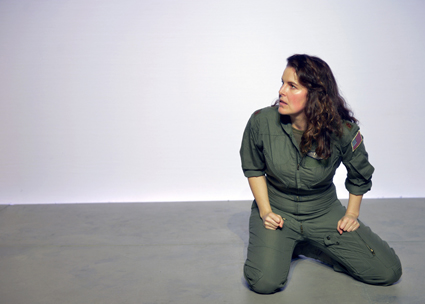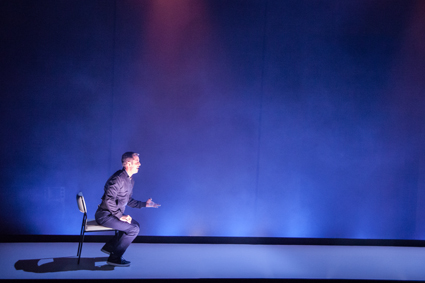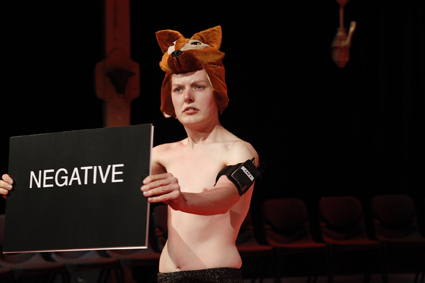Braving the limits of the monologue
John Bailey: Red Stitch, Angus Cerini, BalletLab

Kate Cole, Red Stitch Actors Theatre, Grounded
photo Jodie Hutchinson
Kate Cole, Red Stitch Actors Theatre, Grounded
The monologue is one of theatre’s base elements. With just a little fussing around in the chemistry set, the simplest solo performance can still create sparks, fire, the smell of crackling air. Or it can squat there before you like a lump of lead for an hour or more. Can anything really new be done with the monologue as a mode? Three recent Melbourne works hinted at the possibility.
Grounded
George Brant’s Grounded doesn’t immediately announce itself as terribly exceptional, but a production by Red Stitch Actors Theatre proved one of the company’s most memorable outings to date. The work’s materiality is minimal—the already small playing space is bare of props and the design is merely a subtle rendering to the walls suggestive of the interior of a military vehicle. The entire 80-minute work is performed by a single actor (Kate Cole) who does not leave the stage, and barely moves around it. Yet this is a work whose astonishing strengths come from precisely its manipulation of the immaterial components of live performance.
The subject matter itself is arresting enough. An American F16 fighter pilot stationed in the Middle East falls pregnant while on furlough back in the US and finds herself reassigned to the cold world of drone warfare. Brant’s treatment of this premise is outstanding, too. Striking images pile up from the outset: morning sickness while piloting an F16; the reasons pregnant women are barred from flying (think ejector seats); the contrast between the endless blue sky of the pilot and the tiny windowless unit of the desk-bound drone jockey.
So far, so conventional. But it is through the dynamic relationship between Cole’s mighty performance and Matthew Adey’s equally rich lighting design that the work truly soars. Cole delivers a character grounded in more ways than one. This is an earthy creature, despite her profession. Her swaggering braggadocio and coiled-spring energy are well beyond the Top Gun clichés that could have reduced the work to pastiche, and the giddy acceleration of the work’s early moments brings to mind that other great monologue that overflows with life, that of Molly Bloom’s “yes I said yes I will Yes” at the end of Ulysses. That the audience can be dragged into the slipstream of a character who also defines herself by the slaughter of war is testament both to Cole’s bravery and Kirsten von Bibra’s precise direction.
While voice, gesture and rhythm work to produce a fertile sense of presence here, of life in fullness, Adey’s lighting offers an equally charged atmosphere of transcendence and the vacuum that is both ethereal and deathly. The pilot’s job is one of heavenly surveillance and this notion of bodiless witness from upon high—and deadly judgement thereafter—is a theme throughout the work. Adey’s almost imperceptible modulation of light often makes terrific use of after-images, giving Cole a faint halo as your eyes move slightly, or causing her skin to take on unearthly hues. The avenging angel at this work’s centre is literally brought before us, and that after-image in particular lasts well after the lights are finally out.

Angus Cerini, Resplendence
photo Sebastian Bourges
Angus Cerini, Resplendence
Resplendence
Angus Cerini’s Resplendence is another work that takes place in a void but is far from empty. Here an unnamed man in a black bomber jacket fixates on a source of sharp light to one side of the stage—a television set most likely—and spends a Butoh-ish amount of time working his way across the space towards it. So quotidian is his situation that it might as well be the fridge light, really, but as usual Cerini’s command of language and its unconventional deployment renders the everyday with mythic undertones.
The man is angry at the world, or riven by anxieties about it, and as with many of Cerini’s characters his body-wracking inabilities to quell these responses are a visceral reminder of masculinity’s more threatening aspects. When the man does leave his house to hunt down some takeaway, it’s hard not to muster some deal of dread, at least if you are familiar with a typical Cerini work.
But this is not a typical Cerini work. Midway through its unfolding, its central figure witnesses a tragedy that violently rips him from his solipsism. He is forced to act—or, more importantly, to react to an event that occurs before him rather than in the world he projects from the safety of his own head. It’s a riveting moment, given that Cerini has proven so adept at bringing audiences into those disturbing worlds before. Here he illustrates what prisons they are by allowing us a brief glimpse past the bars at a patch of daylight somewhere down the hall. To describe this as optimistic would be wrong—the man never even dreams of a key to his cell, let alone escapes—but it is a work that signals a hurdle leapt by its maker with verve and grace.

LIVE WITH IT we all have HIV, Phillip Adams BalletLab in collaboration with Andrew Hazewinkel
photo Jeff Busby
LIVE WITH IT we all have HIV, Phillip Adams BalletLab in collaboration with Andrew Hazewinkel
LIVE WITH IT we all have HIV
Phillip Adams’ LIVE WITH IT we all have HIV is an even more radical departure from standard practice for the artist. It is a series of ‘portraits’ by real subjects touched by HIV over the past 30 years, and Adams has almost completely eschewed his role as choreographer in favour of a kind of curatorial position, establishing the conditions within which these non-professional performers present their own stories. He has collaborated with visual artist Andrew Hazewinkel throughout the process, and the results are each a kind of monologue not limiting themselves to the theatrical definition of the mode.
The work itself is hard to categorise. The agents on stage don’t perform, as such, but rather present their stories—as rambling monologues in the more traditional sense, as solo movement pieces, as pre-recorded audio. Most centre on an object that does not symbolise HIV but somehow speaks to someone’s experience of the virus, from pill bottles to record covers to a laptop. Between vignettes, medical and historical facts instruct or remind us of the incredible changes that have occurred in both Australian society and the status of HIV around the world in only a few decades.
These are not finely calibrated performances, and they are not carefully arranged by a puppetmaster working to shape the audience’s experience into some kind of narrative. Indeed, while some of the sequences are surprisingly literal, an equal number are abstracted, difficult to discern or simply odd. Some commentators were left baffled or bemused by the succession of voices that did not seek to justify themselves, but were simply made available to be heard. Some compared it to a kind of workshop, and perhaps it was. As theatre not too much was accomplished, though many tears were shed. But whatever it was, as it drew to a close I was surprised to realise after two hours without interval, I could happily have kept watching for the rest of the night.
Red Stitch Actors Theatre, Grounded, writer George Brant, director Kirsten von Bibra, performer Kate Cole, design Matthew Adey, composer Elizabeth Drake, Red Stitch Actors Theatre, 11 June-12 July; Resplendence, creator, performer Angus Cerini, dramaturgy, additional direction Susie Dee, designer Marg Horwell, composer Jethro Woodward, lighting Andy Turner, Lawler Theatre, Melbourne Theatre Company, 12-22 June; Artshouse, Phillip Adams BalletLab, in collaboration with Andrew Hazewinkel and community participants from Melbourne and regional Victoria, LIVE WITH IT we all have HIV, Meat Market, Melbourne, 17-27 July
RealTime issue #122 Aug-Sept 2014 pg. 46






